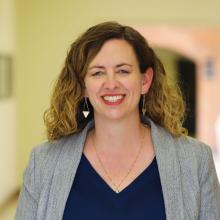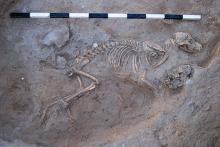Centuries of Canine Companionship
The latest research by Dr. Deirdre Fulton is shining light on how ancient peoples lived with their dogs
Baylor’s Dr. Deirdre Fulton is a professional archeologist whose extended family maintains a healthy interest in what she discovers through her work. In fact, you might even say that her in-laws, in particular, go above and beyond — and even below — in their support.
“They’ll say, ‘Deirdre, we were walking through the woods and we found this dead fox,’” she said, and they will then take the carcass and bury it on their land in Massachusetts.
“The soil is quite sandy and really excellent for excavating,” Fulton said, which makes her job easier a couple of years down the road, when the family gathers to dig up that fox or deer or whatever other deceased creatures her relatives have found.
“We bury it for two or three years then excavate it for fun,” Fulton said. “I have the kids help me with that.”
Fulton has even been known to bury the bone from a cut of meat after an Easter meal.
“I think this pork shoulder looks particularly interesting,” she remembers saying, and wondering how old the animal was when it died.
These are not ghoulish obsessions. For Fulton, an associate professor of religion who joined the College of Arts & Sciences faculty in 2013, the exercise of excavating dead animals “for fun” directly supports her professional archeological work. All of these various bones, gathered in many different ways, become part of Fulton’s comparative collection for use in her ongoing research and teaching about ancient food practices.
Ancient Dog Burials
For several years, Fulton has been involved in excavating animal bones, including those of dogs, in the ancient seaport of Ashkelon, located in southern Israel on the coast of the Mediterranean Sea.
“Ashkelon is famous in the Bible for being one of the cities of the Philistines,” she said. “That’s part of the reason archaeologists wanted to excavate Ashkelon — to see if the Philistine culture and the city looks different from what they know about the Judahites (and) the Israelites, so they can do a comparison and contrast among these different groups. That’s one of the research questions we are trying to answer.”
Fulton first worked at the archaeological site in Ashkelon in 2009 when she was a doctoral student at Penn State. That was four years after she had started working in a Penn State laboratory with Dr. Brian Hesse, who directed the Jewish Studies Program at the university. He died in 2011, and Fulton has continued to work with his widow, Dr. Paula Wapnish Hesse, a zooarcheologist who worked at the Ashkelon site from 1985 until 2016. Fulton and Hesse are now collaborating on a book-length treatment on dog burials in the same area during the Persian and early Hellenistic periods — from the late fifth century into the third century, B.C.
“We have uncovered something between 1,200 to 1,400 dog burials,” Fulton said. “I’m not just interested in that they are dogs. I’m interested in this culturally — the significance of dogs to these people in the city of Ashkelon, who were suddenly burying dogs for this window of time when they didn’t do it before, and they didn’t do it after. What happened that made them decide, ‘I think this is a good time to bury dogs?’”
One theory is that after the Philistine city of Ashkelon was burned by King Nebuchadnezzar in 604, it lay abandoned for about 100 years. Then, a new population — the Phoenicians — moved in.
“Around their houses, near streets and in unoccupied land around the settlement, the people who lived in Ashkelon would bury dogs,” Fulton said. “It’s the craziest thing. We don’t exactly know why. But what Dr. Hesse and I are trying to do with this publication is show the data that we have, over the last 30 years, and what we have been finding with these dogs and our analysis of them. People are very interested in animals, particularly dogs. People like to read about dogs, even old ancient dogs, and they have a lot of interest in this research.”
During the summer of 2021, Fulton received a Baylor University Digital Humanities summer grant to map the Ashkelon dog burials. She was assisted by Joshua Been, director of data and digital scholarship and digital scholarship librarian for Baylor University Libraries, as well as two other BU Libraries staff members — Dr. Christina Chan-Park, STEM coordinator, and Bill Hair III, theology, associate professor and religion and philosophy librarian.
Going Viral
Fulton was also the co-author of an article in the journal Science “that kind of went viral in the archaeological world,” she said. “The New York Times picked it up because it’s about dogs, and dogs sell as a topic in my world. If I want to have something make more of a splash, I write about dogs.”
The article, which was published in The New York Times in October 2020, examines human and dog genomes and migratory patterns.
“It’s taking a global perspective on questions concerning the domestication of dogs — not just a regional perspective,” Fulton said. “And DNA studies of animals have taken off in the last 15 to 20 years. DNA studies and research, as well as people’s interest in their own ancestry, is everywhere. It also follows that people are interested in the ancestry of animals too, particularly in an academic setting.”
Fulton said what probably got her article originally published in Science is an “enormous data set,” which she contributed some Ashkelon dog samples to, that tracks when dog and human migration occur simultaneously, and when they occur separately.
“When other scholars come along with more points, they can insert them into this big research data set and we may have an even bigger picture of these events,” she said.
Student Involvement
Fulton’s study of dogs and other animal bones from Ashkelon ties in with the religion courses she teaches at Baylor, which include Christian Scriptures, Hebrew, Prophets and, of course, Archaeology and the Bible.
“When I teach the Archaeology and the Bible class, I talk about all the different types of subspecialties as specializations in archaeology, and I run little labs,” she said. “I’ve cleaned (the bones) beforehand. They’ve been disinfected, so students can actually, physically, hold an animal bone. Not all students want to touch animal bones. Some of them think it’s gross, but many of them are very interested. I also have labs on ceramic pottery, and I have them hold ceramic artifacts. We have some ancient pots here at Baylor. I also have them look at and hold other types of artifacts, such as ancient coins.”
Fulton often holds informal week-long training sessions for her students before they head out on their first archaeological excavations, to give them an idea of what they might find in the field.
“You can mistake bones for other finds,” she said, “and so I want my students to have the feel of it before they go into the actual field to excavate.”
Each summer, Fulton spends a few weeks in Israel doing research. She mainly works inside a laboratory, but she will go out into the field if the archeologists and volunteers unearth “something very special,” such as an entire skeleton.
“If you find me a whole donkey skeleton that’s 4,000 years old, I will come out and make sure that I have sketched it out and photographed it, described it, and had measurements made in what we call in place — in situ — of the animal bones,” she said.
While in the lab, Fulton examines bones of animals that have been excavated and tries to answer seemingly simple questions as: What kind of animal is this? How old is it? Was it diseased before it died?
“But I don’t have a laboratory with everything in it, so it’s my brain doing the processing through and checking,” she said. “Of course, I also have books and comparative collections that I can access online, from University College London and other sites. I have ways to figure it out if my brain doesn’t click, but I’ve looked at more than 500,000 animal bones at this point in time. So, it’s a really fun puzzle that I'm trying to solve.”
A Family Affair
Besides her work in Ashkelon, Fulton also is part of a team working on the Baylor-led San Giuliano Archaeological Research Project, a site in Italy about 43 miles from Rome. A number of Baylor faculty members are involved, including co -directors Dr. Colleen Zori, senior lecturer in the Honors College, and Dr. David Zori, associate professor in the Honors College; Dr. Lori Baker, vice provost for faculty development and diversity and professor of anthropology; and Dr. Alden Smith, professor and Master Teacher of Classics.
Also on the San Giuliano team is Fulton’s husband, Dr. James Fulton, an assistant professor of geosciences at Baylor.
“My husband and I do share a wee bit of overlap in research,” she said. “He’s doing more geologically driven, isotopic questions. And I can talk to him about aspects of animal-human interactions.”
The Fultons’ research interests affect a few parts of their lives off campus — such as family vacations.
“We both really are interested in telling stories about something ancient — ancient processes, for one thing — and so we look down at the ground a lot. We go to a national park, and while you’d think we would be looking up at the trees or the mountains, we seem to be looking down. I’m always like, ‘Are we going to find an arrowhead or something else?’ We joke about how our children can only look down, so we make sure to look up so that they know what other things are there when we’re walking around.”


